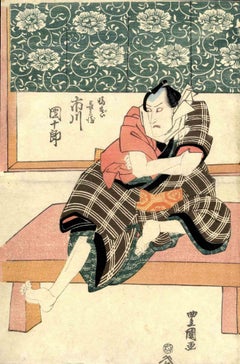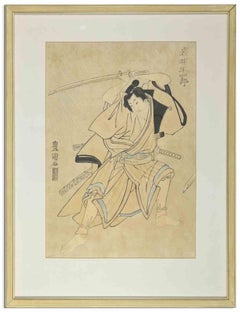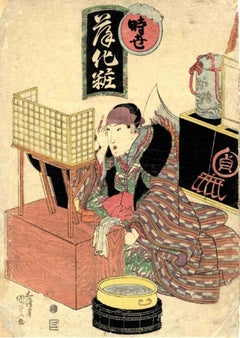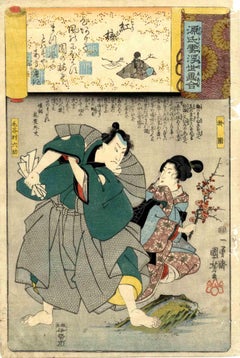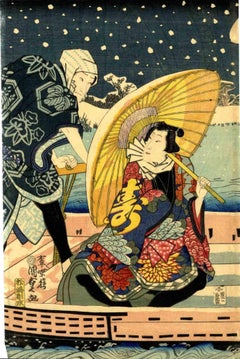Art by Medium: Woodcut
to
186
2,401
310
127
91
125
Overall Width
to
Overall Height
to
6
550
2,144
356
18
32
188
225
90
119
197
100
90
63
5
2,509
502
253
215
198
109
58
45
41
26
5
3
1
2,138
819
83
1,404
742
551
472
395
358
342
280
278
224
212
206
184
157
141
112
109
100
73
70
4,850
49,399
38,061
26,283
25,329
131
72
50
29
29
215
1,721
1,351
743
Style: Modern
Style: Contemporary
Style: Art Deco
Medium: Woodcut
Ichikawa Danjuro in the Role of Chobei - Woodcut by Utagawa Toyokuni - 1810s
Located in Roma, IT
Ichikawa Danjuro in the role of Chobei is an original modern artwork realized by Utagawa Toyokuni (Edo, 1769 – Edo, 1825).
Original Woodcut Print.
Oban from a Triptych, around 1810.
The actor Ichikawa Danjuro sitting on a bench and fretting, behind him a green curtain with peony motif.
Signed: Toyokuni ga. Publisher: Yamamotoya Heikichi.
Excellent impression, cut, centrefold, a little bit rubbed and soiled.
Utagawa Toyokuni (Edo, 1769 – Edo, 1825), also often referred to as Toyokuni I...
Category
1810s Modern Art by Medium: Woodcut
Materials
Woodcut
Actor Iwai Hanshiro as a Samurai by Utagawa Toyokuni I - Early 19th Century
Located in Roma, IT
Actor Iwai Hanshiro as a Samurai is an artwork realized by Utagawa Toyokuni (1769-1825), in the early 19th Century
Color woodcut, signed or inscribed in the top right and bottom lef...
Category
Early 19th Century Modern Art by Medium: Woodcut
Materials
Woodcut
Delicate Makeup in Fashion - Woodcut Print by Utagawa Kunisada - 1830
Located in Roma, IT
Delicate makeup in fashion is an original modern artwork realized by Utagawa Kunisada in 1830s.
Woodcut Print Oban Dyptich Format. From the series "Jisei usugesho" (Delicate makeup in fashion). An actor prepares him self for a rolle as Onnagata in a Shosagoto play, with the ghost characters of the sister Matsukaze and Murasame. He sits in front of a makeup table and applies makeup to his eyebrows, behind him on a black lacquer shelf...
Category
19th Century Modern Art by Medium: Woodcut
Materials
Woodcut
Kabukie - Woodcut by Utagawa Kuniyoshi - 1850
Located in Roma, IT
Kabukie is an original modern artwork realized by Utagawa Kuniyoshi (1798 – 1861) in the half of the 19th Century.
Original woodcut from the series...
Category
1850s Modern Art by Medium: Woodcut
Materials
Paper, Woodcut
Kabuki - Woodcut by Utagawa Kunisada II - 1862
Located in Roma, IT
Kabuki is an original artwork realized in 1862 by Utagawa Kunisada II (1823-1880).
Boatman with elegant passenger in snowy landscape.
Sign: Kochoro Kuni...
Category
1860s Modern Art by Medium: Woodcut
Materials
Woodcut
From the suite La Passion
Located in San Francisco, CA
This artwork from the suite "La Passion" 1932, published 1939 is a wood engraving by French artist Georges Rouault, 1871-1958. (Block engraved by Georges Aubert) It is signed and dat...
Category
Early 20th Century Modern Art by Medium: Woodcut
Materials
Woodcut
Henry R. Diamond, Whaler
By Henry R. Diamond
Located in New York, NY
Really a wood engraving rather than a woodcut, Henry R. Diamond's Whaler is majestic. It is signed and titled in pencil.
Category
Early 20th Century American Modern Art by Medium: Woodcut
Materials
Woodcut
Sumo Fighters - Woodblock Print by Utagawa Kunisada - Mid-19th Century
Located in Roma, IT
Sumo Fighters is an original Woodcut print realized in mid 19th century by Utagawa Kunisada.
Good condition and Beautiful colored woodblock print.
This wonderful modern artwork re...
Category
Mid-19th Century Modern Art by Medium: Woodcut
Materials
Woodcut
Kabuki Scene - Woodblock Print by Utagawa Kunisada - Mid-19th Century
Located in Roma, IT
Kabuki Scene is an original Woodcut print realized in mid 19th century after Utagawa Kuniyoshi (1797-1861).
Good condition and Beautiful colored woodblock print.
This wonderful mo...
Category
Mid-19th Century Modern Art by Medium: Woodcut
Materials
Woodcut
Rex (woodcut print, male figure, neutral colors, pattern)
By Susan Kiefer
Located in Kansas City, MO
Susan Kiefer
Rex
Woodcut on paper
Year: 2000
Size: 27x22in
COA provided
Ref.: 924802-1663
Framed woodcut print. A nude male figure in an armchair with striped and patterned backgrou...
Category
Early 2000s Contemporary Art by Medium: Woodcut
Materials
Woodcut, Paper
$1,555 Sale Price
40% Off
Lovers - Woodcut Print on Paper By Robert Bonfils - Mid 20th Century
Located in Roma, IT
Lovers is an original artwork realized by Robert Bonfils (1886-1972). Original woodcut print on paper, realized on early-20th century, hand signed in pencil by the artist on the lowe...
Category
Mid-20th Century Modern Art by Medium: Woodcut
Materials
Woodcut
The Radiant Prince Genji - Woodcut Print by Utagawa Kunisada - 1850s
Located in Roma, IT
Plate from Faithful Images of the Radiant Prince Genji is an original modern artwork realized by Utagawa Kunisada in 1850s.
Woodcut print Oban yokoe format.
From the series "Sono...
Category
19th Century Modern Art by Medium: Woodcut
Materials
Woodcut
Yamabayashi Fusahachi - Woodcut Print by Utagawa Kunisada - 1860s
Located in Roma, IT
Yamabayashi Fusahachi is an original modern artwork realized by Utagawa Kunisada in 1861.
Woodcut print Oban from a multi-heet, 1861
Actor in the role of Yamabayashi Fusahachi sta...
Category
19th Century Modern Art by Medium: Woodcut
Materials
Woodcut
The Actor Nakamura Shikan II - Woodcut Print by Utagawa Hirosada - 1850
Located in Roma, IT
The Actor Nakamura Shikan II is an original modern artwork realized by Utagawa Hirosada (Japanese, active 1825–75) in 1850.
Original woodcut print chuban format, 1850. Signed Hirosada. Publisher: Kagawa. From the series "Kokon yujin ki" (Transcription on past and present heroes). The actor Nakamura Shikan II as Danshichi Kurobei in the play Natsumatsuri Naniwa kagami.
Excellent impression, fresh in colour, with blindstamping (floral design), visible wood grain (grey kimono...
Category
19th Century Modern Art by Medium: Woodcut
Materials
Woodcut
HAIL AND FAREWELL
Located in Portland, ME
Kent, Rockwell. HAIL AND FAREWELL. Burne-Jones 55. Wood engraving, 1930. Edition of 120. 8 x 5 1/2 inches, 203 x 140 mm. Signed in pencil. In excellent condition.
Category
1930s American Modern Art by Medium: Woodcut
Materials
Woodcut
Les Hommes a/p cvII (blue/green variant), by Fernando Reyes
Located in Palm Springs, CA
Signed on the front, and signed, titled and numbered on the reverse, This is an artist proof, unique color variant, aside from the edition of 15. An abstraction of male nudes.
In J...
Category
21st Century and Contemporary Contemporary Art by Medium: Woodcut
Materials
Woodcut
Sumo Fighter - Woodblock Print by Utagawa Kunisada - Mid-19th Century
Located in Roma, IT
Sumo Fighter is an original Woodcut print realized in mid 19 century by Utagawa Kunisada.
Good condition and Beautiful colored woodblock print, included a cardboard passpartout (45...
Category
Mid-19th Century Modern Art by Medium: Woodcut
Materials
Woodcut
Passenger Pigeon - Woodcut Print by Alexander Francis Lydon - 1870
Located in Roma, IT
Passenger Pigeon is a modern artwork realized in 1870 by the British artist Alexander Francis Lydon (1836-1917) .
Woodcut print, hand colored, publi...
Category
1870s Modern Art by Medium: Woodcut
Materials
Woodcut
Les Soirs d'Opium - Woodcut after Jean Paul Sauget - 1921
Located in Roma, IT
Les Soirs d'Opium is a woodcut print print on paper, realized after Jean Paul Sauget for Maurice Magre's Les Soirs d'Opium.
Published in 1921.
Good conditions.
Category
1920s Modern Art by Medium: Woodcut
Materials
Woodcut
Old Samurai - Woodcut Print after Utagawa Kunisada - Late 19th Century
Located in Roma, IT
Old Samurai is a Woodcut print realized in late 19 century after Utagawa Kunisada.
Good condition and Beautiful colored woodblock print, included a cardboard passpartout (46x32 cm...
Category
Late 19th Century Modern Art by Medium: Woodcut
Materials
Woodcut
Chillida, Composition, Derrière le miroir (after)
Located in Southampton, NY
Woodcut on vélin paper. Inscription: Unsigned and unnumbered, as issued. Good condition. Notes: From Derrière le miroir, N° 174, 1968. Published by Aimé Maeght, Éditeur, Paris; print...
Category
1960s Modern Art by Medium: Woodcut
Materials
Woodcut
$716 Sale Price
20% Off
Cat - Original woodcut, Handsigned and Numbered /160 - Buisson #27-03
Located in Paris, IDF
Leonard Tsuguharu FOUJITA
Cat, 1927
Original woodcut
Handsigned with ink
Numbered /160
Bears the blind stamp of the editor (Lugt 1140a)
On Vellum 32.5 x 25.5 cm (c. 13 x 10 inch)
R...
Category
1920s Modern Art by Medium: Woodcut
Materials
Woodcut
English Antique Woodcut Engraving, Signed, of Prose by Robert Bridges
Located in Cirencester, Gloucestershire
Woodcut Engraving of "The Love of all Beauteous Things", poem by Robert S Bridges (1844-1930, British poet and poet laureate 1913-1930.
by Henry Clarence Whaite (British 1895-1978)
o...
Category
20th Century Modern Art by Medium: Woodcut
Materials
Woodcut
Toadstool - Woodcut by Maurits Cornelis Escher - 1931
Located in Roma, IT
Woodcut print realized by Escher for the series "Emblemata", and published in 1931.
On Hollande van Gelder paper.
Edition of 300.
Unsigned, as issued. Excellent condition, matted....
Category
1930s Modern Art by Medium: Woodcut
Materials
Woodcut
Chinese Herbal Book - Rare Illustrated Book - 19th century
Located in Roma, IT
Chinese Herbal Book is a Rare book with beautiful oriental herbal wood prints realized in the 19th century.
In 29 pages.
All titled in Chinese.
In go...
Category
19th Century Modern Art by Medium: Woodcut
Materials
Paper, Woodcut
$709 Sale Price
30% Off
Kabuki Scene - Woodblock Print by Utagawa Kunisada - Mid-19th Century
Located in Roma, IT
Kabuki Scene is an original Woodcut print realized in mid 19 century by Utagawa Kunisada.
Good condition and Beautiful colored woodblock print.
This wonderful modern artwork repr...
Category
Mid-19th Century Modern Art by Medium: Woodcut
Materials
Woodcut
Hollyhocks
Located in Fairlawn, OH
Hollyhocks
Color woodcut, 1953
Signed with the artist's stamp lower left
Printer: Niimi
Carver: Nagashima
An early printing
Condition: Excellent
Image size: 15 1/2 x 10 3/8 inches
"...
Category
1950s Modern Art by Medium: Woodcut
Materials
Woodcut
"Casa Marquez" Original Woodblock Print, Signed and Numbered 93/100
Located in Soquel, CA
"Casa Marquez" Original Woodblock Print, Signed and Numbered 93/100
Boldly colored woodblock print by Carol Summers (American, 1925-2016). This piece is a closeup on a large stone building, with a landscape reflected in the windows. The building has carved ornamentation in a classical style. There is a bright red sunset in the background behind the building. The title refers to the author Gabriel García Márquez.
Signed "Carol Summers" in the lower right corner.
Numbered and titled "93/100 Casa Marquez" in the upper right corner.
Presented in a silver colored aluminum frame.
Frame size: 19.25"H x 23.25"W
Paper size: 16"H x 20"W
Carol Summers (1925-2016) has worked as an artist throughout the second half of the 20th century and into the first years of the next, outliving most of his mid-century modernist peers. Initially trained as a painter, Summers was drawn to color woodcuts around 1950 and it became his specialty thereafter. Over the years he has developed a process and style that is both innovative and readily recognizable. His art is known for it’s large scale, saturated fields of bold color, semi-abstract treatment of landscapes from around the world and a luminescent quality achieved through a printmaking process he invented.
In a career that has extended over half a century, Summers has hand-pulled approximately 245 woodcuts in editions that have typically run from 25 to 100 in number. His talent was both inherited and learned. Born in 1925 in Kingston, a small town in upstate New York, Summers was raised in nearby Woodstock with his older sister, Mary. His parents were both artists who had met in art school in St. Louis. During the Great Depression, when Carol was growing up, his father supported the family as a medical illustrator until he could return to painting. His mother was a watercolorist and also quite knowledgeable about the different kinds of papers used for various kinds of painting. Many years later, Summers would paint or print on thinly textured paper originally collected by his mother.
From 1948 to 1951, Carol Summers trained in the classical fine and studio arts at Bard College and at the Art Students League of New York. He studied painting with Steven Hirsh and printmaking with Louis Schanker. He admired the shapes and colors favored by early modernists Paul Klee (Sw: 1879-1940) and Matt Phillips (Am: b.1927- ). After graduating, Summers quit working as a part-time carpenter and cabinetmaker (which had supported his schooling and living expenses) to focus fulltime on art. That same year, an early abstract, Bridge No. 1 was selected for a Purchase Prize in a competition sponsored by the Brooklyn Museum.
In 1952, his work (Cathedral, Construction and Icarus) was shown the first time at the Museum of Modern Art in New York City in an exhibition of American woodcuts...
Category
1980s Contemporary Art by Medium: Woodcut
Materials
Ink, Handmade Paper, Woodcut
$1,722 Sale Price
35% Off
The Sailboat - Original woodcut, Handsigned
Located in Paris, IDF
Edward PELLENS
The Sailboat, 1922
Original woodcut
Handsigned in pencil
Numbered /154
On vellum 32.5 x 25.5 cm (c. 13 x 10 in)
Bears the blind stamp of t...
Category
1920s Art Deco Art by Medium: Woodcut
Materials
Woodcut
Tengmalm's Owl - Woodcut Print by Alexander Francis Lydon - 1870
Located in Roma, IT
Tengmalm's Owl is a modern artwork realized in 1870 by the British artist Alexander Francis Lydon (1836-1917).
Woodcut print on ivory-colored paper.
Hand-colored, published by Lond...
Category
1870s Modern Art by Medium: Woodcut
Materials
Woodcut
Lesser Black-Backed Gull - Woodcut Print by Alexander Francis Lydon - 1870
Located in Roma, IT
Lesser Black-Backed Gull is a modern artwork realized in 1870 by the British artist Alexander Francis Lydon (1836-1917) .
Woodcut print, hand colored, published by London, Bell & S...
Category
1870s Modern Art by Medium: Woodcut
Materials
Woodcut
Yakushae - Woodcut Print by Utagawa Kunisada - 1863
Located in Roma, IT
Yakushae is an original modern artwork realized by Utagawa Kunisada in 1863.
Woodcut print oban from a tryptich. Signed Toyokuni ga. Publisher: Izutsuya. Scene from the play "Yowa Nasake Ukina no Yokogushi". Yasugoro, the thief with the bat tattoo on his cheek, enters the oil merchant's house at night...
Category
19th Century Modern Art by Medium: Woodcut
Materials
Woodcut
“Volcano Fuego” Modern Colorful Abstract Landscape Woodcut Print Ed. 74/75
Located in Houston, TX
Colorful abstract landscape woodcut print by modern artist Carol Summers. The work features a color blocked depiction of a volcano with a rainbow. Signed, titled, and editioned withi...
Category
1970s Contemporary Art by Medium: Woodcut
Materials
Woodcut
Japanese Accessories - Woodcut after Utagawa Kunisada - Late-19th century
Located in Roma, IT
Japanese Accessories is a Woodcut print realized in the first half of the 19th century by Utagawa Kunisada.
Good condition.
This wonderful modern artwork represents Japanese acce...
Category
Late 19th Century Modern Art by Medium: Woodcut
Materials
Woodcut
Illusion : Boy, Cat and Soap Bubbles - Original woodcut, Handsigned
Located in Paris, IDF
Gabriel BELOT
Illusion : Boy, Cat and Soap Bubbles, 1922
Original woodcut
Handsigned in pencil
Numbered /154
On vellum 32.5 x 25.5 cm (c. 13 x 10 in)
Bears the blind stamp of the ed...
Category
1920s Art Deco Art by Medium: Woodcut
Materials
Woodcut
Paris, Luxembourg Garden - Original wooodcut, Handsigned and numbered /105
Located in Paris, IDF
Emile BOIZOT
Paris, Luxembourg Garden - 1920
Original woodcut
Handsigned in pencil
Numbered /165
On vellum 32.5 x 25.5 cm (c. 13 x 10 in)
Bears the blind...
Category
1920s Art Deco Art by Medium: Woodcut
Materials
Woodcut
Ex Libris - Giorgio Balbi - Woodcut - Mid-20th Century
Located in Roma, IT
Ex Libris - Giorgio Balbi is an Artwork in Mid 20th Century.
Woodcut.
Good conditions.
Category
Mid-20th Century Modern Art by Medium: Woodcut
Materials
Woodcut
"Diocletian's Retreat, " Woodcut and Monotype signed by Carol Summers
Located in Milwaukee, WI
"Diocletian's Retreat" is a woodcut and monotype signed by Carol Summers. The image combines landscape and architecture, in this case a classical struc...
Category
1990s Contemporary Art by Medium: Woodcut
Materials
Monotype, Woodcut
The Bead Seller, Modern Woodcut Print by Stephen White
Located in Long Island City, NY
Stephen White - The Bead Seller, Year: 1978, Medium: Woodblock on Japon, signed, dated, titled and numbered in pencil, Edition: 6/150, Size: 26.75 x 24.5 in. (67.95 x 62.23 cm)
Category
1970s Modern Art by Medium: Woodcut
Materials
Woodcut
Kabuki - Woodcut by Utagawa Kunisada II - 1840
Located in Roma, IT
Kabuki is an original artwork realized in 1864 by Utagawa Kunisada II (1823 1880).
Scene at night in a snowy forest, the actor Ichikawa Kodanji in the ro...
Category
1850s Modern Art by Medium: Woodcut
Materials
Woodcut
Alhambra XII
Located in New York, NY
Antonio Frasconi created the color woodcut entitled “Alhambra XII” in 1963. This piece is signed titled, and dated in pencil. The edition is 12, and paper size is 18 x 24 inches. “...
Category
1960s American Modern Art by Medium: Woodcut
Materials
Woodcut
One Hundred Fifty Feet Down
Located in Dallas, TX
Eleanor Jones Harvey, Chief Curator at the Smithsonian American Art Museum, wrote about Bob Stuth-Wade:
“Over the course of his career, Bob Stuth-Wade has examined his responses t...
Category
21st Century and Contemporary Contemporary Art by Medium: Woodcut
Materials
Woodcut
Sawamura Tosho - Woodcut Print by Utagawa Kunisada - 1862
Located in Roma, IT
Sawamura Tosho is an original modern artwork realized by Utagawa Kunisada in 1862.
Woodcut print Oban from a tryptich
Signature Kio Toyokuni ga (77 Toyokuni). Publisher: Soshuya. ...
Category
19th Century Modern Art by Medium: Woodcut
Materials
Woodcut
Nakamura Utaemon - Woodcut by Utagawa Kunisada - 1840
Located in Roma, IT
Nakamura Utaemon is an artwork realized in 1840 by Utagawa Kunisada (1786-1865).
Nakamura Utaemon in the role of the fox spirit Ukiyo Matagoro frightens the court lady Benno Naishi...
Category
1840s Modern Art by Medium: Woodcut
Materials
Woodcut
Pochard - Woodcut Print by Alexander Francis Lydon - 1870
Located in Roma, IT
Pochard is a modern artwork realized in 1870 by the British artist Alexander Francis Lydon (1836-1917).
Woodcut print on ivory-colored paper.
...
Category
1870s Modern Art by Medium: Woodcut
Materials
Woodcut
Still Life - Woodcut Print by Domenico Cantatore - Mid-20th Century
Located in Roma, IT
Still Life is a contemporary artwork realized by Domenico Cantatore in the mid-20th Century.
Mixed colored woodcut print. Edition 52/75.
Hand signed by the artist on the lower marg...
Category
Mid-20th Century Modern Art by Medium: Woodcut
Materials
Woodcut
Figure - Original Woodcut Print by Amadore Porcella - Early 20th Century
Located in Roma, IT
Figure is an original woodcut print realized by Amadore Porcella.
The state of preservation of the artwork is very good.
Passepartout dimension: ...
Category
Early 20th Century Modern Art by Medium: Woodcut
Materials
Woodcut
Boat (study for estuary)
Located in New York, NY
Richard Bosman (b. 1944) is a painter and printmaker known for his woodcuts depicting turbulent seascapes. He studied at Bryam Shaw School of Painting and Drawing in London, The New ...
Category
Late 20th Century Modern Art by Medium: Woodcut
Materials
Woodcut
$480 Sale Price
40% Off
Abstract, Geometric Composition
Located in Kansas City, MO
Medium: Woodcut
Year: 1990
Signed, numbered and dated by hand
Edition: 25
Size: 32.4 × 20.7 on 41.5 × 29.4 inches
COA provided
Works in public or private collections:
Art Museum Bon...
Category
1990s Contemporary Art by Medium: Woodcut
Materials
Woodcut
$444 Sale Price
30% Off
Bijinga - Woodcut print by Utagawa Kunisada - 1844
Located in Roma, IT
Bijinga is an original artwork realized in 1844 by Utagawa Kunisada (1786-1865).
From the series "Hyakunin isshu esho" (Girl's pictures and 100 poets' card games), 14th sheet.
You...
Category
1840s Modern Art by Medium: Woodcut
Materials
Woodcut
Actor in Onnagata Role - Woodcut Print by Utagawa Kuniyoshi - 1850s
Located in Roma, IT
Actor in onnagata role accompanied by a kamuro is an original artwork realized in the 1850s by Utagawa Kuniyoshi (January 1, 1798– April 14, 1861).
Woodcut Print.
Sign.: Ichiyusai ...
Category
1850s Modern Art by Medium: Woodcut
Materials
Woodcut
Sumo Tournament - Woodblock Print by Utagawa Kunisada - Mid-19th Century
Located in Roma, IT
Sumo Tournament is an original Woodcut print realized in mid 19TH century by Utagawa Kunisada.
Good condition and Beautiful colored woodblock print.
This wonderful modern artwork represents Japanese Sumo...
Category
Mid-19th Century Modern Art by Medium: Woodcut
Materials
Woodcut
Damien Hirst's Dog
Located in Deddington, GB
Damien Hirst’s Dog By Mychael Barratt [Mychael Barratt]
limited_edition
Woodcut
Image size: H:50 cm x W:51 cm
Complete Size of Unframed Work: H:63...
Category
21st Century and Contemporary Contemporary Art by Medium: Woodcut
Materials
Woodcut
Kabuki - Woodcut by Sawamura Tanosuke - 1862
Located in Roma, IT
Kabuki is an original artwork realized in 1862.
Breast portrait of the actor Sawamura Tanosuke in front of a dark blue background, as Kanehira's daughter, in the inset portrait of B...
Category
1860s Modern Art by Medium: Woodcut
Materials
Woodcut
Art Deco City Scene with Motor Car print by Gerald Mac Spink
Located in London, GB
To see our other Modern British Art, scroll down to "More from this Seller" and below it click on "See all from this Seller" - or send us a message if you cannot find the artist you ...
Category
Early 20th Century Art Deco Art by Medium: Woodcut
Materials
Woodcut
Untitled, Edition - 5/5, Woodcut on Paper by Jogen Chowdhury "In Stock"
Located in Kolkata, West Bengal
Jogen Chowdhury - Untitled
Edition - 5/5
Woodcut on Paper
Print Size - 7.1 x 9.6 inches
Paper Size - 9.5 x 14.8 inches
2019
(Unframed & Delivered)
Modern Indian artist Jogen Chowdh...
Category
2010s Modern Art by Medium: Woodcut
Materials
Paper, Woodcut
Ryoanji Temple in the Snow at Sunset- Woodcut by Hasegawa Sadanobu-1850
Located in Roma, IT
Ryoanji Temple in the Snow at Sunset is an original artwork realized in 1850 by Hasegawa Sadanobu (1809-1979).
Chuban yokoe.
From the series "Miyako meisho no uchi", Famous Viws o...
Category
1850s Modern Art by Medium: Woodcut
Materials
Woodcut
Harvesting Young Cedars - Woodcut by Utagawa Hiroshige - 19th Century
Located in Roma, IT
Harvesting Young Cedars is a lovely original woodcut print from the work of the famous Japanese master Utagawa Hiroshige from an early 19th century edition. It represents an agricult...
Category
19th Century Modern Art by Medium: Woodcut
Materials
Woodcut
Painter Fisherman - Woodcut by Mino Maccari - Mid 20th Century
By Mino Maccari
Located in Roma, IT
Painter Fisherman is a woodcut artwork realized by Mino Maccari.
Included a white Passepartout: 49 x 34 cm.
The state of preservation is very good.
The artwork represents a boy hu...
Category
Mid-20th Century Modern Art by Medium: Woodcut
Materials
Woodcut
Blue Face from the Brushstroke Figures Series
Located in Miami, FL
Lithograph, waxtype woodcut and screenprint on 638-g/m cold-pressed Saunders Waterford Paper. From the "Brushstroke Figures" series, 1989. Hand signed rf Lichtenstein, dated ('89) a...
Category
1980s Contemporary Art by Medium: Woodcut
Materials
Lithograph, Screen, Woodcut
Woodcut art for sale on 1stDibs.
Find a wide variety of authentic Woodcut art available on 1stDibs. While artists have worked in this medium across a range of time periods, art made with this material during the 21st Century is especially popular. If you’re looking to add art created with this material to introduce a provocative pop of color and texture to an otherwise neutral space in your home, the works available on 1stDibs include elements of orange, yellow, purple, blue and other colors. There are many well-known artists whose body of work includes ceramic sculptures. Popular artists on 1stDibs associated with pieces like this include Mino Maccari, Utagawa Kunisada (Toyokuni III), Eric Gill, and Utagawa Hiroshige. Frequently made by artists working in the Modern, Contemporary, all of these pieces for sale are unique and many will draw the attention of guests in your home. Not every interior allows for large Woodcut art, so small editions measuring 0.04 inches across are also available
Recently Viewed
View AllMore Ways To Browse
German Propaganda Poster
George And Martha
Golfers Watercolor
Glasgow Girls
Globe Watch
Golf Watercolor Art
Gold Whistle
George Edwards Engravings
George Allan Art
Hamer Vintage
Miniature Portrait Of A Lady
Golf Course Prints
Goddess Dior
Gorilla Sculpture
Ghost Watch
George Edwards Bird Prints
Gouache Naples
G Wright Art
